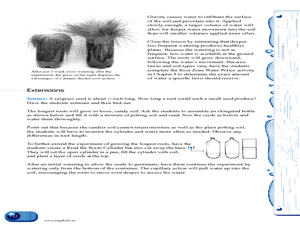Curated OER
Let's Talk About Painting
Discuss art and read Matthew's Dream. In this visual arts lesson, students recognize that there are different styles of art, each with its own techniques. Use simple techniques to understand art and work at stations to...
Scholastic
It's a Whatchamacallit
Learners formulate new applications for simple machines in an original invention that solves a common problem. They brainstorm ideas for a new product using simple machines and communicate a finished project through an oral,...
Curated OER
Looks Good Enough to Eat
Students examine food photography and the different techniques used by food stylists to make foods look appealing in advertisements. After learning some of the tricks of the trade, students plan and shoot their own food advertisements.
Curated OER
Weather Map Challenge
In this weather worksheet learners use a weather map to answer given questions. Students answer questions using map symbols and make predictions based on map. Learners create additional questions with answers using the same map.
Curated OER
Earth Day - Hooray
Students listen to the story, Earth Day - Hooray!, and discuss the story as it is being read. For this Earth Day lesson, students discuss incentives and penalties in regards to taking care of the Earth. This lesson plan also...
Curated OER
Scavenger Hunt: Who am I?
In this solar system worksheet, students use an on line source to find the names of the people who discovered the planets, comets, asteroids, black holes and the idea of the big bang theory.
Curated OER
What's Up With Updrafts?
Students demonstrate how hail and rain are suspended in the air during a storm. For this lesson on storms and weather, students use a hair dryer and ping pong ball to demonstrate how hail and rain can be suspended in the air during a storm.
Curated OER
How Do You Make A Tornado?
Students create a tornado in a bottle. In this climate and weather lesson, students review basic information about tornadoes and thunderstorms. Students make a tornado in a bottle and write about what they learned from the project....
Curated OER
Read The Roots
Students experiment to determine the best watering schedule to use when growing grass. In this grass watering instructional activity, students examine rye grass seeds and discuss the role roots play in keeping grass healthy. They grow...
Curated OER
The Atoms Family Album
In this atomic structure worksheet, students read a story with characters acting as the particles in an atom. They create a trading card for each particle, draw the structure of an atom and sing an atom song.
Curated OER
Staying Up
Students will explain the Archimedes's Principle. For this lesson on plankton, students will describe three factors that can affect the buoyancy of plankton. This lesson contains extensive background information, extensions, and multiple...
Curated OER
The Census of Marine Life
Young scholars explain diversity and abundance in marine life. In this oceanic biology lesson plan, students collect information for various geographical areas to collect a census of marine life.
Curated OER
It's the Law
Students explain various scientific laws used in SCUBA diving. In this theory based lesson plan, students examine and explain how temperature, density, and salinity relate to SCUBA diving using various scientific laws to engage their...
Curated OER
The Atoms Family Album
In the atom instructional activity, learners read a story about the "Atoms Family" and are given descriptions of the structures of atoms through the story. Students interpret the descriptions by drawing the described atom structure, they...
National Constitution Center
To Sign or Not to Sign: The Ultimate Constitution Day Lesson Plan
Young scholars examine the ratification process. In this U.S. Constitution lesson plan, students discuss the ratification process and read a play based on the process. Young scholars debate the ratification process and determine whether...
Curated OER
An Oceanographic Proxy
Students conduct experiments on a sample of sea water. In this oceanography lesson, students inquire how conductivity is used to approximate the salinity ocean water. Students construct their own conductivity meters and test...
Curated OER
the biggest Plates on Earth
Students understand the movement of tectonic plates. In this tectonic plates lesson plan, students access prior knowledge of convergent, divergent, and transform boundaries. Students discuss energy transfer involved in plate...
Curated OER
Something from Nothing
Learners identify opportunity costs. In this resources instructional activity students are read the story Something from Nothing by Phoebe Gilman. Learners list the things Grandpa makes Joseph. Students state why people make choices.
Curated OER
Pond Life
Environmental explorers create an experiment related to ponds and then present their finding to the class. This resource is extremely open-ended. It needs more concrete objectives and procedures for meeting them.
Curated OER
Civic Engagement for Us?
Learners identify the different forms of civic engagement. They identify their responsibilities at the different levels of government. They also analyze young leaders running for office.
Curated OER
Tolerance: Words that Hurt/Words that Heal
Students "role-play" the part of a person who says unkind things and are photographed while doing so. They then act out a story about making friends. They practice saying kind things and are photographed. Word bubbles are added...
Curated OER
Town Along the Chesapeake Bay
Fourth graders make a drawing of a town along a river off of the Chesapeake Bay in Maryland. Upon completion, they give an oral description of their town, including its houses, stores, businesses, farm area, government, etc., and will...
Curated OER
Rhythm and Art: Painting
Students make connections between music and visual art. In this integrated arts lesson, students design paintings that challenge them to examine the relationship between art elements and principles.
Curated OER
Does it Measure Up?
Use this fun activity with youngsters learning how to use rules for measurement. Each is provided with six steps that direct them to draw specific things with specific heights or lengths. For example, they start by drawing a tree that is...
Other popular searches
- Media Center Map Skills
- Library Media Center
- School Library Media Center
- Media Center Orientation
- Media Center Games
- Media Center Lesson Plans
- Media Center Lessons
- Alphabet Media Center
- Media Center Vocabulary
- Media Center Rules
- Atlas Media Center
- Using Media Center























